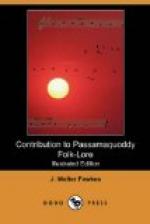[Music illustration:
Way ho yah-nie, way ho yahnie, way ho yahnie, way ho yahnie, way ho yah-nie, way ho-yah.
Hew na-yie hah, hew na-yie hah, hew nayie hah, hew nayie hah, hew nayie hah.]
The leader or singer, whom we may call the master of the ceremony, begins the dance by moving about the room in a stooping posture, shaking in his hand a rattle made of horn, beating the ground violently with one foot. He peers into every corner of the room, either seeking the snake or inciting the on-lookers to take part, meanwhile singing the first part of the song recorded on the phonograph. Then he goes to the middle of the room, and, calling out one after another of the auditors, seizes his hands. The two participants dance round the room together. Then another person grasps the hands of the first, and others join until there is a continuous line of men and women, alternate members of the chain facing in opposite directions, and all grasping each other’s hands. The chain then coils back and forth and round the room, and at last forms a closely pressed spiral, tightly coiled together, with the leader in the middle. At first the dancers have their bodies bent over in a stooping attitude, but as the dance goes on and the excitement increases they rise to an erect posture, especially as near the end they coil around the leader with the horn rattles, who is concealed from sight by the dancers. They call on the spectators to follow them, with loud calls mingled with the music: these cries now become louder and more boisterous, and the coil rapidly unwinds, moving more and more quickly, until some one of the dancers, being unable to keep up, slips and falls. Then the chain is broken, and all, with loud shouts, often dripping with perspiration, return to their seats.[6]
[Footnote 6: The last part of this dance somewhat resembles a play among boys, known as “Snap the whip.”]
In this dance all present take part; it always occurs at the end of the Passamaquoddy dances, though it may be followed by a dance of the Micmacs, or other foreign Indians. There was, when last presented, no special dress adopted for the snake-dance, and the horn rattle is used also in other dances. It seems probable that everything used in the old times has disappeared, with the exception perhaps of the last-named implement, yet the song resembles closely that of the olden time. The invitations to dance are possibly introduced, and the boisterous finale may be of modern date. There is recorded also on the phonograph, with the song, the invitation to the dance in the Passamaquoddy language. An invitation is extended to all to come to the dance. It is a proclamation that there will be a good time, much to eat, “Indian dances,” snake dance, and Micmac dances. The shell of the turtle was used in old times for a rattle, in place of the horn, and in a story of the origin of the rattlesnake the conqueror is said to use a rattle of this kind. In the




